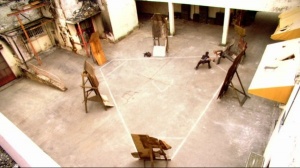Pyramid (RDM)
More actions
Re-imagined Series
Pyramid, as a court game
A popular game within Colonial society, possibly team-based, which enjoyed television coverage across the the Twelve Colonies (Mini-Series), and also popular aboard Colonial warships (Litmus).

The game appears to be a close quarters ball game played on a pyramid-shaped court, hence the name of the game Pyramid. The objective is apparently to score points by getting the ball into a goal at the top of the pyramid. The game appears to be a cross between basketball, rugby and lacrosse. Pyramid can be played one-on-one or in teams. Pyramid is also played professionally, teams like the Caprica Buccaneers are sports heroes akin to modern day professional sports teams. While teams can consist of upwards of eight people it is probable that the sport is played with players rotating on and off the court between plays. The Pyramid court that Starbuck and Anders played on, which was regulation size in spite of it's makeshift layout, didn't look much bigger than a tether ball circle. It is unlikely that it can support up to 16 players at one time. (Resistance)
According to the first issue of The Official Magazine Battlestar Galactica (pp. 28-29), there are versions of Pyramid for one, three or five players from each team on the court at once. The play area is consistantly refered to as an "arena" and the corner with the goal as the "head". Apparently each team starts out in one of the corners besides the head and then vie for control of the ball. The initial ball placement is unspecified, but a face-off is mentioned tangentally later in the article with no details.
Players can take no more than "three paces" without passing, shooting, or rebounding the ball off of one of the walls. The outlined areas in the corners and the center of the arena are "neutral zones". When a player places the ball in these zones, other players must back off and may not make contact (BSG Magazine). This may be a rule somewhat like the NCAA's old "halo" on the declaration of a fair catch of a kick off (speculation).
Full contact is allowed (when the ball is not in a neutral zone), and once a player has been tackled, they must pass the ball (BSG Magazine). How this is handled in one-on-one games is left unspecified. The game is won by the team with the most points at the end (ibid.). However, under what circumstances the games ends is also left unspecified. Perhaps, like basketball, a pick-up game could be played to a certain number of points and professional (or otherwise more official) games have a clock or other timer.
The arena shown in Resistance was apparently designed for "three (on) a side" and, "maybe in a professional area(sic) you would be able to play with up to five people on a side," (BSG Magazine). Whether this implies that this court is built to some specifications other than professional (as High School and Collegate football fields in America have different regulations than NFL fields), or simply that only professionals play with five players on the field is rather hard to determine.
The ball is, "about the size of a cantaloupe," between the sizes of a softball and soccer ball. Apparently the size, combined with the cupped structure of the goal mean that outside (towards the side-lines) shots are quite a bit more difficult than inside (towards the center of the arena) shots. However, the more inside you get, the more defense there will likely be. This is one of the chief reasons the game is so physical: battling over the good shooting space directly in front of the goal (BSG Magazine).
The game is derived from the triad games played in the original Battlestar series.
Pyramid, as a card game
See: History of the Term "Pyramid" for information.
Original Series
A high-risk chancery game played with cards; a Colonial version of poker.
History of the Term "Pyramid"
To clarify the confusion of "pyramid", one must first realize that in the original series, pyramid referred to the poker type card game often played by the Viper pilots.
In the re-imagined series, pyramid is often confused with the card game now known in the re-imagined series as Full Colors. There was a mix-up by Ronald D. Moore; he confused "pyramid" (the original series' card game) with "triad" (the original series sports game), which was entered into the canon from the Mini Series and into the television series.
As a result the current series' pyramid became a sport while the card game was dubbed "Full Colors".
